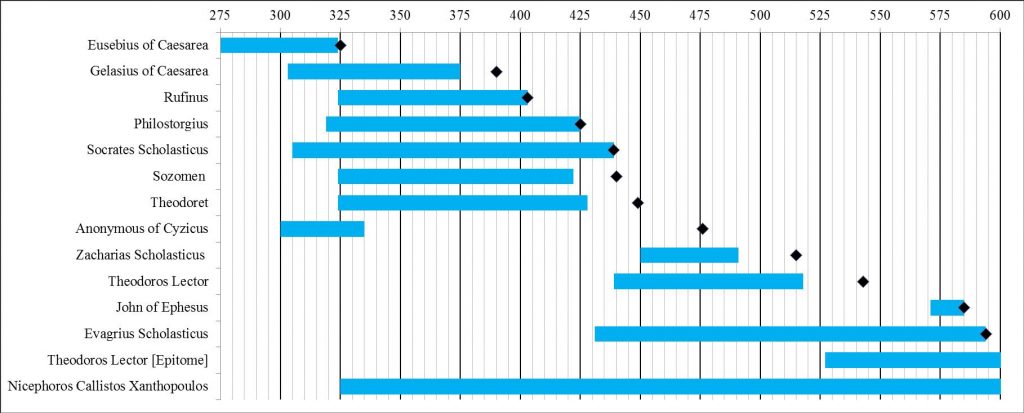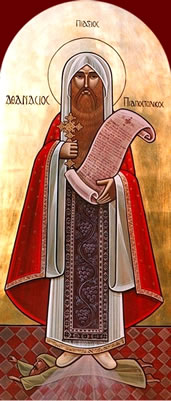Early Church Historians
After the New Testament book of Acts, few early sources provide narrative accounts of the history of the earliest centuries of the Christian church. For the years following Jesus’s ascension we are heavily dependent on the Church History of Eusebius of Caesarea, the first major historian of the church. His work covers the period up to the death of Licinius (c. AD 30-324). While its historical accuracy is not uniform and his own theological and political biases are at times prominent, Eusebius’s Church History was and still is our best ancient narrative source for the people and events within the church during the second and third centuries.
Eusebius’s work was so widely admired and accepted that no contemporary author attempted to replace or supplement it. By the fifth century, however, other Christian writers did feel the need to continue the story of the church’s development during the pivotal fourth century and up until their own day. They either continued from where Eusebius had ended or briefly reprised the events at the beginning of the fourth century to provide the necessary background for the events which followed. Similar to the work of Eusebius, these church histories often contain evident theological and political biases.
Among these “continuators” of Eusebius, three authors and their church histories stand out: Socrates Scholasticus, Sozomen, and Theodoret. All three of these men continued the history where Eusebius left off. Although the styles of these authors and, at times, their information and chronologies vary, all three recount the history of the church in the fourth century, and thus they often describe the same church figures and events. In order to easily compare and contrast the accounts of these men, we have created a Harmony of the Fourth-Century Historians which lays out the parallel accounts of Socrates, Sozomen, and Theodoret side by side.
However, these three men were not the only ones to continue the work of church history begun by Eusebius. The following chart lists the major historians of the Greek and Latin church who wrote about the history of the church of the fourth, fifth, and sixth centuries.
| Historian |
Years Covered | Christian Beliefs | Date of History’s Completion | CPG |
| Eusebius (Caesarea) | c. 30-324 | c. 325 | 3495 | |
| Gelasius (Caesarea) | 303-375 | Orthodox | c. 390 | 3521 |
| Rufinus (Aquileia) | 324-403 | Orthodox | 403 | (Latin) |
| Philostorgius (Constantinople) | 319-425 | Eunomian | 425-433 | 6032 |
| Socrates Scholasticus (Constantinople) | 305-439 | Orthodox | c. 439 | 6028 |
| Sozomen (Constantinople) | 324-422 | Orthodox | 440-443 | 6030 |
| Theodoret (Cyrus) | 324-428 | Orthodox | 449-450 | 6222 |
| Anonymous (Cyzicus) | 300-335 | Orthodox | c. 476 | 6034 |
| Zacharias Scholasticus (Mytilene) | 450-491 | Moderate Monophysite | c. 515 | 6995 |
| Theodoros Lector (Constantinople) | 439-518 | Orthodox | c. 543 | 7503 |
| Evagrius Scholasticus (Antioch) | 431-594 | Orthodox | c. 594 | 7500 |
| John (Ephesus) | 571-585 | Monophysite | c. 585 | (Syriac) |
| Theodoros Lector [Epitome] | 527-610 | |||
| Nicephoros Callistos Xanthopoulos (Constantinople) | 325-610 | c. 1320 |
This chart is based primarily on Winkelmann’s chart between pages 208 and 209 of his “Kirchengeschichtswerke.”
* The blue bar indicates the years covered by that author’s church history.
** The black diamond indicates the approximate date of the completion of that author’s church history.
Bibliography:
Siniscalco, P. “Christian Historiography.” In Encyclopedia of Ancient Christianity. Edited by Angelo Di Berardino. Downers Grove, IL: InterVarsity Press, 2014, Vol. 2, pp. 261-267.
Winkelmann, F. “Kirchengeschichtswerke” in Quellen zur Geschichte des frühen Byzanz (4.-9. Jahrhundert). Bestand und Probleme. Edited by F. Winkelmann and W. Brandes. Amsterdam: Gieben, 1990, p. 202-212.
Created by NJ 2017-1-24
Last updated by NJ 2017-2-18
No Responses yet

